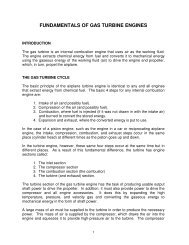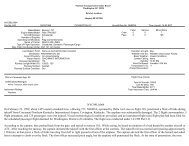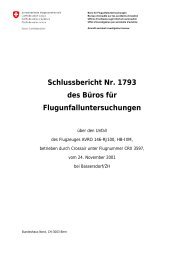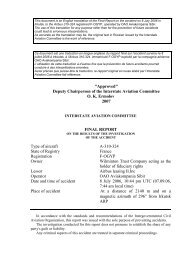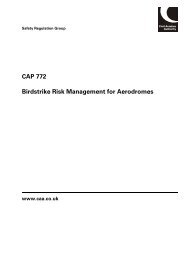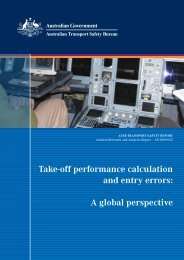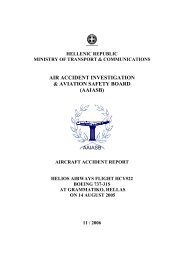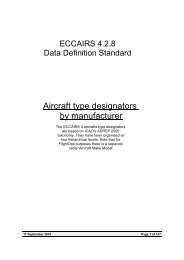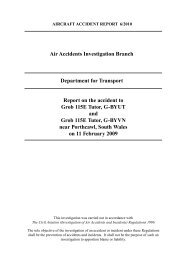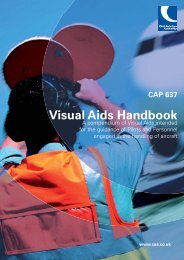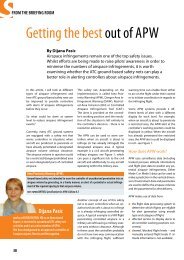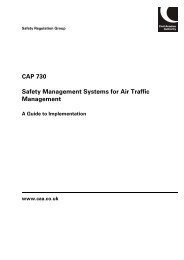Staying safe during an aircraft depressurisation - SKYbrary
Staying safe during an aircraft depressurisation - SKYbrary
Staying safe during an aircraft depressurisation - SKYbrary
Create successful ePaper yourself
Turn your PDF publications into a flip-book with our unique Google optimized e-Paper software.
The actual time of useful consciousness will be<br />
shorter with faster rates of <strong>aircraft</strong><br />
<strong>depressurisation</strong> or if you are exercising (such as<br />
running to your seat). Hypoxia symptoms c<strong>an</strong><br />
also be worse <strong>an</strong>d time of useful consciousness<br />
shorter for people with respiratory or heart<br />
conditions, who are smokers or are unfit, or have<br />
been drinking alcohol.<br />
Physiological altitude<br />
If a passenger is a smoker or is physically out of<br />
shape, they will be at greater risk of altitude<br />
injuries th<strong>an</strong> a physically fit person.<br />
Smoking three cigarettes in rapid succession, or<br />
smoking 20-30 cigarettes in a 24-hour period<br />
prior to flying c<strong>an</strong> tr<strong>an</strong>slate into a physiological<br />
altitude of <strong>an</strong> additional 3,000 to 5,000 ft.<br />
Source: Reinhart, 1996<br />
Trapped gas<br />
Air travellers may experience discomfort <strong>an</strong>d<br />
pain in their middle ear, sinuses, teeth, or<br />
stomach when the <strong>aircraft</strong> is climbing or<br />
descending. This is because our bodies contain<br />
gas in these cavities, <strong>an</strong>d the gas is influenced<br />
by the ch<strong>an</strong>ges in the pressure outside the body<br />
(i.e. the cabin air pressure).<br />
It is more difficult for gas to ‘equalise’ in the<br />
middle ear cavity when the cabin pressure<br />
altitude is descending th<strong>an</strong> when it is climbing.<br />
In addition, a person’s level of discomfort<br />
depends on the rate at which the cabin altitude<br />
ch<strong>an</strong>ges. When the <strong>aircraft</strong> is climbing or<br />
descending, the cabin pressure altitude is<br />
generally increased or decreased at a rate of no<br />
more th<strong>an</strong> about 300-500 ft/min to minimise<br />
passenger discomfort (MacMill<strong>an</strong>, 1999).<br />
However, <strong>during</strong> <strong>an</strong> explosive or rapid<br />
<strong>depressurisation</strong>, the cabin pressure altitude c<strong>an</strong><br />
climb at a considerably higher rate (see box in<br />
the next column) <strong>an</strong>d c<strong>an</strong> result in pain. A rapid<br />
<strong>aircraft</strong> descent following a <strong>depressurisation</strong> c<strong>an</strong><br />
also lead to pain, sometimes worse th<strong>an</strong> the<br />
pain associated with the actual <strong>depressurisation</strong>.<br />
This is because it is more difficult for the inner<br />
ear to equalise when the altitude of the cabin is<br />
decreasing (such as from a rapid <strong>aircraft</strong><br />
descent) th<strong>an</strong> climbing (such as from a<br />
<strong>depressurisation</strong>). The pain experienced c<strong>an</strong> be<br />
worse if passengers have ear <strong>an</strong>d nose<br />
infections. In severe cases, the eardrum c<strong>an</strong><br />
rupture, causing bleeding or leaking of fluid from<br />
the ear.<br />
In a similar way to ear pain, air pressure in the<br />
sinuses equalises with the ambient air pressure<br />
in the cabin through small openings that connect<br />
the sinuses to the nose. If you fly with <strong>an</strong> upper<br />
respiratory infection or hay fever, the gas inside<br />
the sinuses may not escape to equalise the<br />
pressure. As a result, you may experience pain in<br />
the cheeks, forehead or sinuses when the cabin<br />
pressure altitude is descending.<br />
As gas inside your teeth <strong>an</strong>d the gastrointestinal<br />
tract exp<strong>an</strong>ds at high altitudes, a rapid<br />
<strong>depressurisation</strong> c<strong>an</strong> result in discomfort,<br />
bloating <strong>an</strong>d pain. Pain from trapped gas<br />
becomes more signific<strong>an</strong>t if you are suddenly<br />
exposed to cabin altitudes above 25,000 ft.<br />
Boeing 747-400 <strong>depressurisation</strong><br />
The rapid <strong>depressurisation</strong> on the Boeing 747-<br />
400 <strong>aircraft</strong> on 25 July 2008 occurred when the<br />
<strong>aircraft</strong> was cruising at 29,000 ft <strong>an</strong>d the<br />
pressure inside the cabin was equivalent to <strong>an</strong><br />
altitude of 3,700 ft.<br />
Following the <strong>depressurisation</strong>, the cabin<br />
pressure altitude increased to a maximum of<br />
25,900 ft in 41 seconds, increasing by about<br />
60,000 ft/min in the first 20 seconds.<br />
About 20 seconds after the event, the <strong>aircraft</strong><br />
beg<strong>an</strong> to descend to 10,000 ft over about 5 <strong>an</strong>d<br />
a half minutes. During this time, the cabin<br />
altitude slowly reduced from 25,900 ft to<br />
8,000 ft.<br />
- 6 -<br />
(ATSB Preliminary Investigation Report AO-2008-053)<br />
Decompression sickness <strong>an</strong>d cold<br />
injuries<br />
Decompression sickness is caused by the<br />
development of nitrogen bubbles in the body as<br />
a result of reduced atmospheric pressure.<br />
However, it occurs at a much lower rate in<br />
aviation th<strong>an</strong> in SCUBA diving. There have been<br />
no cases recorded of decompression sickness<br />
when exposed to altitudes less th<strong>an</strong> 18,000 ft<br />
(without recent SCUBA diving or hyperbaric<br />
exposure).




